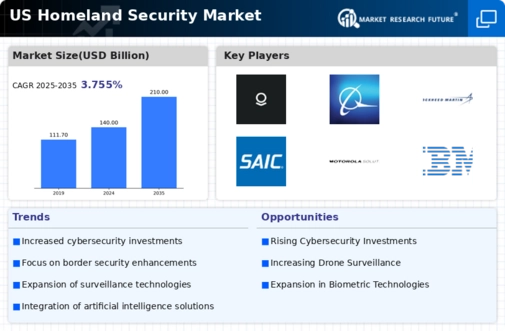The homeland security surveillance camera market is characterized by a dynamic competitive landscape, driven by technological advancements and increasing security concerns. Key players such as Hikvision (US), Axis Communications (SE), and FLIR Systems (US) are at the forefront, each adopting distinct strategies to enhance their market positioning. Hikvision (US) focuses on innovation through the development of AI-powered surveillance solutions, while Axis Communications (SE) emphasizes partnerships with local law enforcement agencies to tailor their offerings. FLIR Systems (US) is leveraging its expertise in thermal imaging to differentiate its products in a crowded market, suggesting a trend towards specialization in surveillance technologies.
The market structure appears moderately fragmented, with numerous players vying for market share. Companies are increasingly localizing manufacturing to reduce supply chain vulnerabilities and enhance responsiveness to regional demands. This tactic not only optimizes operational efficiency but also aligns with the growing emphasis on sustainability and local economic support. The collective influence of these key players shapes a competitive environment where innovation and strategic partnerships are paramount.
In November 2025, Hikvision (US) announced a collaboration with a major tech firm to integrate advanced AI capabilities into its surveillance systems. This strategic move is likely to enhance the functionality of their products, enabling real-time threat detection and analysis, which could significantly improve their competitive edge. The integration of AI is expected to resonate well with clients seeking cutting-edge security solutions, thereby reinforcing Hikvision's market leadership.
In October 2025, Axis Communications (SE) launched a new line of cloud-based surveillance cameras designed specifically for urban environments. This initiative reflects a strategic pivot towards smart city applications, indicating Axis's commitment to addressing the unique challenges faced by urban security. By aligning their product offerings with the needs of modern cities, Axis is positioning itself as a leader in the evolving landscape of urban surveillance.
In September 2025, FLIR Systems (US) expanded its product portfolio by introducing a series of advanced thermal cameras aimed at critical infrastructure protection. This expansion not only diversifies FLIR's offerings but also underscores the growing importance of thermal imaging in security applications. The strategic focus on critical infrastructure aligns with increasing government investments in security, suggesting a robust growth trajectory for FLIR in this niche market.
As of December 2025, the competitive trends in the homeland security surveillance camera market are increasingly defined by digitalization, AI integration, and sustainability. Strategic alliances are becoming more prevalent, as companies recognize the need to collaborate to enhance technological capabilities and market reach. The shift from price-based competition to a focus on innovation and technology is evident, with companies prioritizing supply chain reliability and advanced features to differentiate themselves. This evolution indicates that future competitive differentiation will hinge on the ability to innovate and adapt to emerging security challenges.






















Leave a Comment